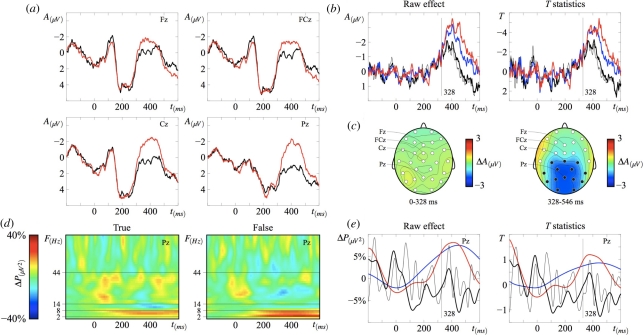Figure 1.
(a) Grand-average ERP waveforms (N = 24) in the two experimental conditions from four electrode sites on the midline. The onset of critical words (‘In July it is very warm/cold outside’) is at 0 ms. The critical word that makes its host sentence false (‘cold’) evokes a larger N400 when compared with the true condition (‘warm’). (b) N400 effect in ERPs evoked by the critical word in the false minus the true condition (left) and t-values from time-resolved randomization statistics (right) for each midline electrode. The first data point at which the N400 effect is statistically significant over two neighbouring centro-parietal sites is at 328 ms and the last one is at 546 ms. (c) Topographic maps showing the mean difference between ERPs evoked by critical words in the false minus the true condition before (0–328 ms) and during (328–546 ms) the N400 effect, which is largest over electrode Pz. Dark circles represent the electrodes over which the effect is statistically significant. (d) Grand-average (N = 24) wavelet-based time-frequency representations (TFRs) from Pz showing a power increase in the false condition relative to the true condition and to baseline in the δ−θ (2–8 Hz) range, and a α (8–14 Hz) power decrease in the true condition relative to the false condition and to baseline. Both effects occurred after 328 ms. No other effects were found at higher frequency bands up to 125 Hz. (e) Raw power changes relative to baseline (left) and t-values from randomization statistics (right) at four selected frequency bands from Pz. (a) Black line, true; red line, false. (b) Red line, Pz; blue line, Cz; black thick line, FCz; black thin line, Fz. (e) Red line, 2–8 Hz; blue line, 8–14 Hz; black thick line, 14–44 Hz; black thin line, 44–80 Hz.

